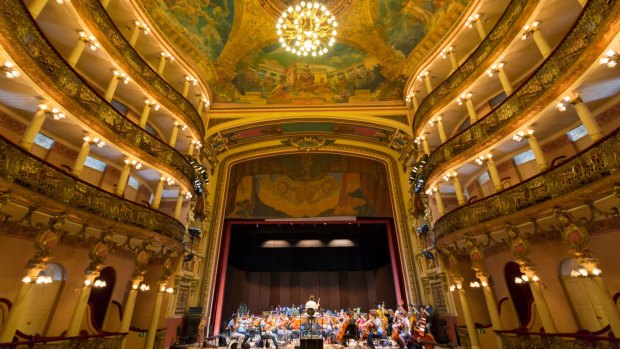
Dazzling: The interior of the Amazon Theatre in Manaus, Brazil.Credit: Alamy
Imagine a city whose residents are so extravagant they water their horses with silver buckets of champagne, install tame lions in their villas and splash millions on a grand Belle Epoque opera house.
It sounds like Paris or St Petersburg. It is, in fact, a wild and isolated place three degrees south of the Equator, in the middle of the Amazon rainforest.
Manaus, at the confluence of two mighty Amazon River tributaries – the Negro and the Solimoes – was once called the Paris of the Jungle, as well as Heart of the Amazon and City of the Forest. For a brief period in the late 1800s, it was one of the gaudiest cities in the world where flaunting wealth became a sport.
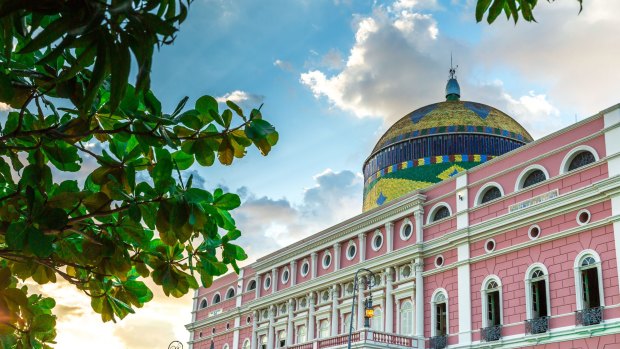
Amazon Theatre in Manaus, Brazil.Credit: Shutterstock
Its sudden and spectacular prosperity sprang from the Amazon's rubber boom, prompting historians to observe that "no extravagance, however absurd, deterred the rubber barons" (reminding those with an eye to history that the human failing for profligacy is a recurring motif).
Manaus, now the capital city of Amazonas in Brazil's north with 2.2 million people, is a fascinating stop on our Captain's Choice ultimate South America by private jet three-week trip, taking in Argentina, Brazil, Cuba, Panama, Ecuador, Peru and Chile's Easter Island.
It's hard to imagine as we fly over olive-hued forest glittering with braided rivers before plummeting into a steamy central cauldron, 1400 kilometres inland from the Atlantic Ocean, that this place was ever anything but dense, primitive jungle. Jungle that covers 60 per cent of Brazil.
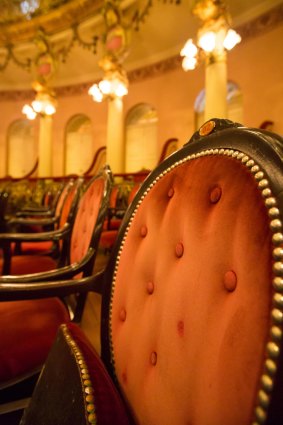
The interior is pure opulence.Credit: Alamy
But greed, vanity and gross brutality attempted to transform it for a time. Stepping off our plane to experience almost unbearable heat and humidity is a reminder that, like the Portuguese rubber barons, we are at the mercy of a natural environment that no amount of wealth can temper.
Our guide tells us we're experiencing a "cold front", with the temperature a "very mild" 35 degrees, with mere 70 per cent humidity because of "wonderful rain" despite the dry season. "It should be 45 degrees," he tells us.
This is the climate into which the Portuguese came in the 17th century. Manaus, meaning mother of the gods in the indigenous tongue, was founded in a strategic location at the meeting of the Amazon's two main tributaries, with fast access from the coast over deep river waters.
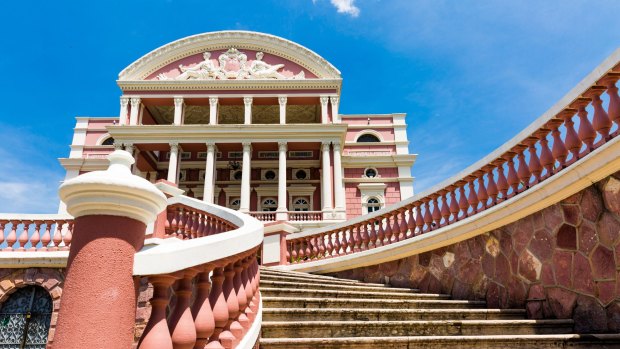
The finely-crafted exterior.Credit: Shutterstock
The dense rainforest was difficult to cultivate until the rubber boom began slowly in the 1850s, booming around 1880 with the invention of the automobile.
En route to Manaus' historic centre and the opera house, we pass rows of factories – some of the 600 international companies attracted to Manaus' Free Trade Zone. Today, foreign manufacturers of tobacco, alcohol, guns and ammunition are enjoying their tax breaks in the true spirit of the rubber barons.
The opera house, or Teatro Amazonas, reveals itself, an enchanting Renaissance-style, salmon-pink wedding cake crafted over 15 years from 1886, using the finest European expertise and materials brought in on ships that left laden with rubber.
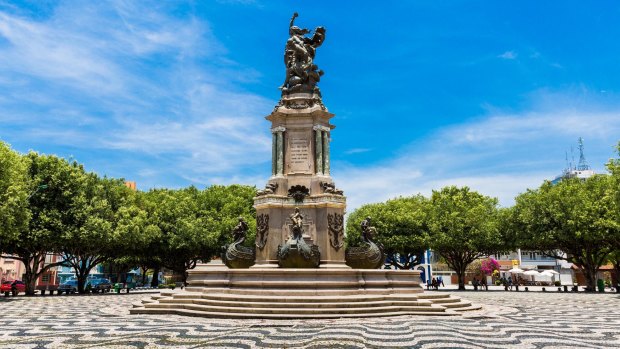
San Sebastian square in downtown Manaus.Credit: SHUTTERSTOCK
Like a cherry on the top is the glittering dome anointed with 36,000 imported vitrified ceramic tiles and painted in Brazil's national colours. The dome enables the impressive opera curtain to be raised without folding or rolling.
The driveways boast just a few surviving rubber cobblestones, installed to muffle the clatter of approaching carriages and allow the windows to stay open for "air-conditioning".
If this is a cold front, I'll eat my hat. We huddle in the shade to admire the Largo Sao Sebastiao (San Sebastian Square) in front of the opera house, with its imposing monument and mesmerising tiling in wavy black and white.
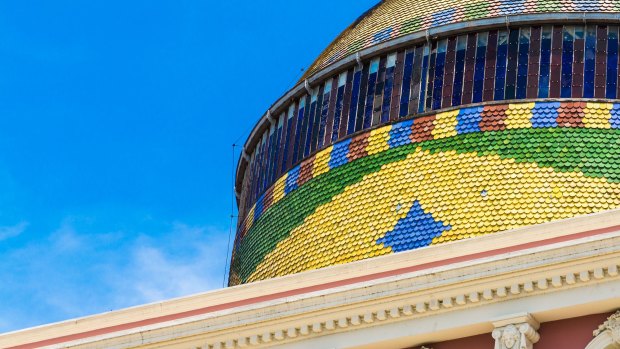
The Brazilian colours adorn the theatre.Credit: Shutterstock
They reflect the meeting of the waters and pay homage to the rivers that provide the local livelihood. They also closely resemble those decorating Rio's Copacabana footpaths.
The 200 Portuguese families, rich beyond belief, and missing their opera, decided to build an edifice similar to Milan's La Scala or Paris' Palais Garnier.
Out of the blinding equatorial light, the opulence of its design and construction is in stark contrast to the deprivation that occurred in the surrounding forest. Thousands of indigenous Amazonians were tortured and enslaved into working the rubber plantations.
Their labour yielded the riches that enabled the Portuguese, disdaining the Amazon's muddy waters, to send their linens to Lisbon or Paris for laundering, eat only imported European food, throw $100,000 banquets, light their cigars with $US100 notes, and become the world's highest consumers of diamonds.
We're looking forward to our private performance by the Amazonas Chamber Orchestra. The tour comes first, taking us through the imposing entrance hall, majestic upstairs grand salon or salao nobre, the outside balconies and finally the 700-seat opera theatre.
Most materials were imported, the construction reputedly costing $US10 million – roofing tiles came from Alsace, steel walls from Glasgow, balconies were of Portuguese stone, columns, stairs and statues were Italian Carrara marble, of the nearly 200 Italian chandeliers, 32 were of Murano glass. Obscene wealth meant electricity came early to Manaus.
Furnishings were Parisian in the French Rococo Louis XV style, Italian artist Domenico de Angelis the Younger painted the panels decorating auditorium and audience chamber ceilings. The Tiffany's curtain is a masterpiece appropriately titled "Meeting of the Waters", painted in Paris by Crispim do Amaral.
In a nod to local materials, the individual seats are made from polished local jacaranda wood and the opera floor is laid with rainforest wood, the same used in La Scala. The grand salon has a wonderful 12,000-piece parquetry floor laid without glue or nails. Vents under seating provided "air conditioning" blown through ice-stocked pipes.
The theatre opened with the production of the Italian opera La Gioconda in January 1897. But many grand dreams turn to ash. An English trader smuggled rubber seeds out of Brazil and rubber plantations sprang up elsewhere. In the 1920s, Manaus quickly lost its glitter and fell into disrepair.
The theatre opened again in 1990 but Manaus residents protested that it was filled with foreign elites. It closed, only opening again in 1997 with the establishment of a permanent philharmonic orchestra.
Our private recital is wonderful and a small group takes up Captain's Choice offer to return for an evening performance by the all-women philharmonic. It's packed with locals, a truly egalitarian occasion.
Despite Brazil's economic woes and the fact that a quarter of Manaus residents live in impoverished favelas, it surely must be a step forward that finally, local people may attend their opera house for little or no cost.
TRIP NOTES
MORE
traveller.com.au/south-america
TOUR
Captain's Choice Journeys by Private Jet. No two Captain's Choice private jet journeys are exactly the same. The Captain's Choice 2018 private jet program features four unique journeys on board a newly chartered Boeing 757, fully customised to seat just 50 people in fully reclinable, luxury Italian leather seats. In the air, an on-board chef provides fresh and delicious meals and the bar offers premium labels and a curated wine list.
The next itinerary to feature South America, Equatorial Explorer, departs London on July 7, 2018, for Bermuda, Havana, Antigua, Cartagena, the Amazon, Atacama Desert, Easter Island and Tahiti, before concluding in Sydney.
This tour is priced from $77,600 a person twin share, all-inclusive, covering all on-tour private jet and other travel arrangements, accommodation, dining and drinks, travel insurance, sightseeing, a valet luggage service and more.
Small changes to 2018 private jet experiences include an upgraded Boeing 757 aircraft, lie-flat leather business seats, a dedicated luxury charter specialist, a reduced number of guests to 50, meaning smaller, boutique luxury accommodation and restaurants and only 12 people per tour group.
For more information, or to order a brochure, call 1800 650 738 or see captainschoice.com.au
Alison Stewart was a guest of Captain's Choice
Sign up for the Traveller Deals newsletter
Get exclusive travel deals delivered straight to your inbox. Sign up now.